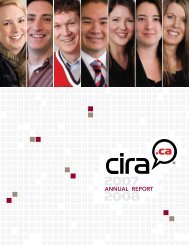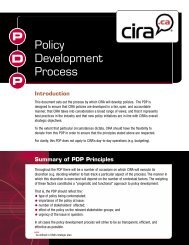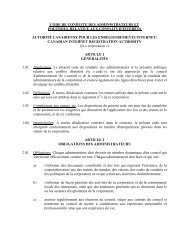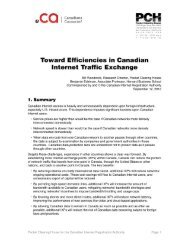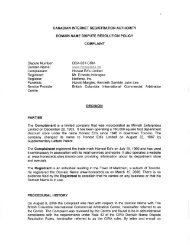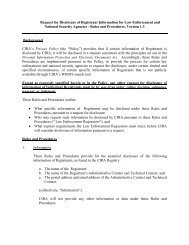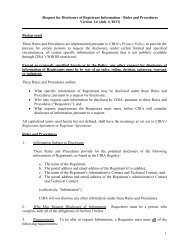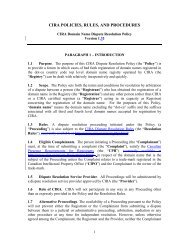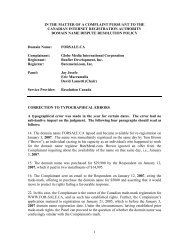00138 - CIRA
00138 - CIRA
00138 - CIRA
Create successful ePaper yourself
Turn your PDF publications into a flip-book with our unique Google optimized e-Paper software.
IN THE MATTER OF A COMPLAINT PURSUANT TO THE<br />
CANADIAN INTERNET REGISTRATION AUTHORITY<br />
DOMAIN NAME DISPUTE RESOLUTION POLICY<br />
Domain Name:<br />
Complainant:<br />
Registrant:<br />
Registrar:<br />
Panelist:<br />
Service Provider:<br />
SHOPNCHEK.CA<br />
Market Force Information Inc.<br />
Joe Smith<br />
DomainPeople Inc.<br />
Teresa Scassa<br />
Resolution Canada, Inc.<br />
DECISION<br />
A. The Parties<br />
1. The Complainant, Market Force Information, Inc., is a corporation incorporated in<br />
Delaware and listing its head office in Louisville, Colorado.<br />
2. The current Registrant and administrative contact person for the disputed domain<br />
name is Joe Smith, with contact information provided for an address in Calgary, Alberta.<br />
B. The Domain Name and Registrar<br />
3. The disputed domain name is SHOPNCHEK.CA. The Registrar for the domain<br />
name is DomainPeople, Inc. The disputed domain name was registered on October 15,<br />
2008.<br />
C. Procedural History<br />
4. This is a proceeding under the Canadian Internet Registration Authority (<strong>CIRA</strong>)<br />
Domain Name Dispute Resolution Policy (Version 1.2) (the Policy) and the <strong>CIRA</strong><br />
Domain Name Dispute Resolution Rules (Version 1.3) (the Rules).<br />
5. The history of the proceeding, according to information provided by the dispute<br />
resolution provider, Resolution Canada, Inc., is as follows:<br />
1
• The Complainant filed a complaint with Resolution Canada, Inc. (the Provider) on<br />
June 8, 2009.<br />
• On June 10, 2009, the Provider notified the Complainant of a deficiency in the<br />
Complaint. This deficiency was corrected by the Complainant by an amendment<br />
forwarded to the Provider on that same date.<br />
• On June 10, the Provider sent an electronic version of the Complaint and the<br />
Amendment to the Complaint to Registrant. The email addresses used were those<br />
supplied by the Registrant as contact information as part of the domain name<br />
registration and on the website to which the disputed domain name resolved. A<br />
hard copy of the complaint was also sent by courier to the address supplied in the<br />
registration. The Registrant did not respond to the Complaint within the 20 day<br />
period prescribed the Rules, para. 5.1.<br />
• As there was no response to the Complaint, the Complainant elected to proceed<br />
with a single panelist.<br />
• On July 8, 2009, the Provider sent a Notice of Selection of Panelist to the parties.<br />
D. Canadian Presence Requirements<br />
6. Under the Policy, the dispute resolution process is open only to eligible<br />
complainants. Paragraph 1.4 of the Policy defines eligibility in these terms:<br />
1.4 Eligible Complainants. The person initiating a Proceeding (the<br />
“Complainant”) must, at the time of submitting a complaint (the “Complaint”),<br />
satisfy the Canadian Presence Requirements for Registrants (the “CPR”)<br />
(currently available at http://www.cira.ca/en/cat_Registration.html) in respect of<br />
the domain name that is the subject of the Proceeding unless the Complaint relates<br />
to a trade-mark registered in the Canadian Intellectual Property Office (“CIPO”)<br />
and the Complainant is the owner of the trade-mark.<br />
7. The Complainant, Market Force Information, Inc., is a company incorporated<br />
under the laws of Delaware. It is the parent company of Shop’N Chek, Inc., a wholly<br />
owned subsidiary of Market Force Information, Inc. The Complainant argues that it<br />
meets the Canadian Presence Requirements by virtue of art. 2(q) of the <strong>CIRA</strong> Canadian<br />
Presence Requirements for Registrants, Version 1.3. Article 2(q) provides:<br />
A Person which does not meet any of the foregoing conditions, but which is the<br />
owner of a trade-mark which is the subject of a registration under the Trademarks<br />
Act (Canada) R.S.C. 1985, c.T-13 as amended from time to time, but in this<br />
case such permission is limited to an application to register a .ca domain name<br />
consisting of or including the exact word component of that registered trademark;<br />
[Emphasis added.]<br />
The Complainant Market Force Information, Inc., is not the owner of the registered trademarks<br />
at issue in this matter. Its subsidiary Shop’N Chek, Inc. holds the Canadian<br />
registered trade-marks for SHOP ‘N CHEK (TMA 1356353), and for a design mark<br />
2
incorporating the words SHOP ‘N CHEK (TMA 1357138). A literal reading of art. 2(q)<br />
of the Canadian Presence Requirements results in a finding that these requirements are<br />
not met in this case. The proper complainant should be Shop ‘N Chek, Inc. This is<br />
confirmed by paragraph 1.4 of the Policy, which also refers to eligibility where “the<br />
Complaint relates to a trade-mark registered in the Canadian Intellectual Property Office<br />
(“CIPO”) and the Complainant is the owner of the trade-mark.” [Emphasis added.]<br />
In other cases involving art. 2(q) and wholly owned subsidiary and parent companies, the<br />
companies that were the actual owners of the registered trade-marks have been the<br />
complainants (see, e.g.: JTH Tax Inc. v. Dhir, <strong>CIRA</strong> Dispute #00125, 2009; General<br />
Motors Acceptance Corp. v. Wood, CIRQA Dispute #00051, 2006; United Business<br />
Media LLC v. TechnoPlanet Productions Inc., <strong>CIRA</strong> Dispute #00129, 2009; Mead<br />
Johnson & Co. v. Turvill Consultants – NARD, Cira Dispute #00063, 2006).<br />
8. In Canadadrugs.com v. NC Britton Holdings, Ltd., <strong>CIRA</strong> Dispute #00028 (2005)<br />
and LPG Systems S.A. v. distribution4web, <strong>CIRA</strong> Dispute #00126 (2009), the panels<br />
found that an exclusive licensee of a CIPO registered trade-mark could meet the<br />
Canadian Presence Requirements in art. 2(q). The panel in Canadadrugs.com wrote:<br />
An exception to this Canadian presence requirement under paragraph 1.4 of the<br />
Policy is that the related trade-mark be registered in the Canadian Intellectual<br />
Property Office. Paragraph 1.4 of the Policy refers to the "owner" of such a<br />
registered trade-mark. However, given that the evident purpose of paragraph 1.4<br />
is to require a proposed complainant to have a sufficiently close connection to<br />
Canada, it is proper to avoid construing the term "owner" in a technical fashion.<br />
The Canadian connection is still maintained if the party is a licensee of a trademark<br />
registered in Canada.<br />
The Complainant has not provided any evidence that they are an exclusive licensee of the<br />
trade-mark rights owned by Shop ‘N Chek. The Complainant has instead provided<br />
evidence that it is the sole owner of Shop ‘N Chek, Inc., which is in turn, the owner of the<br />
Canadian registered trade-mark that is at issue in this case. Like the panel in<br />
Canadadrugs.com, I am reluctant to defeat the purpose of the CDRP through an overly<br />
technical interpretation of the Policy. However, in my view, the Complainant has been<br />
less than convincing that that it meets the Canadian Presence Requirements as required<br />
by the Policy. Nevertheless, accepting for the sake of argument that the requirements are<br />
met, I will consider the other elements of MFI’s Complaint.<br />
F. <strong>CIRA</strong> Domain Name Dispute Resolution Policy Requirements<br />
9. Paragraph 3.1 of the Policy requires the Complainant to establish that:<br />
(a) the Registrant’s dot-ca domain name is Confusingly Similar to a Mark in<br />
which the Complainant had Rights prior to the date of registration of the domain<br />
name and continues to have such Rights;<br />
3
(b) the Registrant has no legitimate interest in the domain name as described in<br />
paragraph 3.6; and<br />
(c) the Registrant has registered the domain name in bad faith as described in<br />
paragraph 3.7.<br />
10. According to paragraph 4.1 of the Policy, the Complainant must establish<br />
elements (a) and (c) above on a balance of probabilities. The Complainant must also<br />
provide “some evidence” that the Registrant has no legitimate interest in the domain<br />
name.<br />
G. Analysis<br />
Confusingly Similar to a Mark in which the Complainant had Rights<br />
11. The Policy requires the Complainant to show, on a balance of probabilities that<br />
“the Registrant’s dot-ca domain name is Confusingly Similar to a Mark in which the<br />
Complainant had Rights prior to the date of registration of the domain name and<br />
continues to have such Rights.”<br />
12. The definition of “Mark” is found in sub-paragraph 3.2 of the Policy. Subparagraph<br />
3.2(c) provides:<br />
3.2 Mark. A “Mark” is:<br />
. . .<br />
(c) a trade-mark, including the word elements of a design mark, that is registered<br />
in CIPO;<br />
13. The definition of “Rights” is found in sub-paragraph 3.3. Sub-paragraph 3.3(b)<br />
provides that a person has Rights in a Mark if:<br />
in the case of paragraph 3.2(c), the Mark is registered in CIPO in the name of that<br />
person, that person’s predecessor in title or a licensor of that person;<br />
14. The registered trade-mark is registered in the name of Shop ‘N Chek, Inc. At the<br />
date of registration, Shop ‘N Chek, Inc. was a wholly owned subsidiary of the<br />
Complainant, Market Force Information, Inc. There is nothing in the Complainant’s<br />
submissions to indicate that MFI is a licensee of the Mark which is owned by Shop ‘N<br />
Chek. The Complainant’s weak claim to having met the Canadian Presence<br />
Requirements also undermines any claim to Rights in the Mark.<br />
15. The Complainant must also establish that its Rights in the Mark predate the<br />
registration of the disputed domain name.<br />
16. The Canadian registered trade-mark SHOP ‘N CHEK was registered on July 10,<br />
2008 for use in association with the following services:<br />
4
(1) Business consulting and business research services, namely shopping by<br />
researchers who pose as customers to evaluate the quality of service delivered,<br />
evaluating customer service and customer satisfaction; market research services;<br />
conducting business and market research surveys; conducting operational audits<br />
of businesses.<br />
17. The disputed domain name SHOP ‘N CHEK.CA was registered on October 15,<br />
2008. The Complainant’s trade-mark registration predates the registration of the disputed<br />
domain name by the Registrant.<br />
18. The Complainant must establish on a balance of probabilities that the disputed<br />
domain name is “Confusingly Similar” to the Mark in which the Complainant has rights.<br />
According to paragraph 3.4 of the Policy, a domain name is confusingly similar to a<br />
Mark when it “so nearly resembles the Mark in appearance, sound or the ideas suggested<br />
by the Mark as to be likely to be mistaken for the Mark.”<br />
19. The Complainant’s submissions on the issue of “Confusingly Similar” are as<br />
follows:<br />
The Registrant’s dot.ca domain name should be considered as confusingly similar<br />
to the mark in which MFI had rights prior to the date of registration of the domain<br />
name. The mark “shopnchek.ca” is strikingly similar to Shop’n Chek.<br />
This is more assertion than argument. The Policy defines “domain name” as “the domain<br />
name excluding the “dot-ca” suffix and the suffixes associated with all third and fourth<br />
level domain names accepted for registration by <strong>CIRA</strong>”. Thus, in determining whether<br />
the domain name SHOPNCHEK.CA is confusingly similar to the Complainant’s Mark<br />
SHOP’N CHEK, one should consider only the SHOPNCHEK portion. If this is done, it<br />
is clear that the domain name is almost identical to the Complainant’s registered trademark,<br />
with only the absent apostrophe and spacing between words being any different.<br />
Although I am of the view that the burden on the Complainant requires more than bare<br />
assertions, I am prepared to accept, for the sake of argument, that confusing similarity has<br />
been established, although, as noted above, the Complainant has not clearly established<br />
that it has rights in the Mark.<br />
Registrant has No Legitimate Interest in the Mark<br />
20. Under sub-paragraph 4.1(c) of the Policy, the Complainant must provide some<br />
evidence that “the Registrant has no legitimate interest in the domain name”. Paragraph<br />
3.6 identifies six circumstances in which a legitimate interest may arise. These are:<br />
(a)<br />
(b)<br />
the domain name was a Mark, the Registrant used the Mark in good faith<br />
and the Registrant had Rights in the Mark;<br />
the Registrant used the domain name in Canada in good faith in<br />
association with any wares, services or business and the domain name<br />
5
was clearly descriptive in Canada in the English or French language of:<br />
(i) the character or quality of the wares, services or business; (ii) the<br />
conditions of, or the persons employed in, production of the wares,<br />
performance of the services or operation of the business; or (iii) the place<br />
of origin of the wares, services or business;<br />
(c)<br />
(d)<br />
(e)<br />
(f)<br />
the Registrant used the domain name in Canada in good faith in<br />
association with any wares, services or business and the domain name<br />
was understood in Canada to be the generic name thereof in any<br />
language;<br />
the Registrant used the domain name in Canada in good faith in<br />
association with a non-commercial activity including, without limitation,<br />
criticism, review or news reporting;<br />
the domain name comprised the legal name of the Registrant or was a<br />
name, surname or other reference by which the Registrant was commonly<br />
identified; or<br />
the domain name was the geographical name of the location of the<br />
Registrant’s non-commercial activity or place of business.<br />
21. The Complainant has made the following submissions with respect to the issue of<br />
the Registrant’s legitimate interest:<br />
• The domain name was not a mark that the Registrant used in good faith. The<br />
Registrant had no rights whatsoever to the mark; and<br />
• The Registrant did not use the domain name in Canada in good faith in<br />
association with any wares, services, or business; and<br />
• The Registrant did not use the domain name in Canada in good faith in<br />
association with any wares, services, or business and the domain name was<br />
not understood in Canada to be the generic name thereof in any language; and<br />
• The Registrant did not use the domain name in Canada in good faith in<br />
association with a non-commercial activity; and<br />
• The domain name did not comprise the legal name of the Registrant or was a<br />
name, surname or other reference by which the Registrant was commonly<br />
identified;<br />
• The domain name was not the geographical name of the location of the<br />
Registrant’s non-commercial activity or place of business; and<br />
• The Registrant has no other legitimate interest in the domain name<br />
22. It is certainly the case the providing “some evidence” of a lack of legitimate<br />
interest in a case where there is no response by the Registrant may be a challenge. In the<br />
past, panelists have accepted evidence of bad faith use of a mark as meeting the threshold<br />
for establishing that a registrant had no legitimate interest because Para. 3.6 of the Policy<br />
requires any uses by a registrant to be in good faith. In Great Pacific Industries, Inc. v.<br />
6
Dhalla, <strong>CIRA</strong> Dispute #00009, 2003), the panel was prepared to find that failure to<br />
respond to the Complainant’s correspondence was evidence that the mark was not used in<br />
good faith. In this case there appears to be one unanswered letter from MFI to the<br />
previous registrant of the domain name, and there has also been no response to the<br />
Complaint. In most cases, however, some evidence of the actual present or past use<br />
being made of the domain name is also provided to give some context for the argument<br />
about legitimate interest. In this case, the Complainant has provided no evidence of the<br />
use of the domain name being made by the Registrant, and no actual argument with<br />
respect to any of the possible grounds for legitimate interest in paragraph 3.6. In my<br />
view, adding a negative to each of the grounds in paragraph 3.6, and placing the negative<br />
in bold font does not meet the relatively low threshold of providing “some evidence” that<br />
there is no legitimate interest on the part of the Registrant.<br />
Registration in Bad Faith<br />
23. The exclusive bases for a finding of bad faith registration are set out in subparagraph<br />
3.7 of the Policy. They are:<br />
3.7 Registration in Bad Faith. For the purposes of paragraph 3.1(c), a<br />
Registrant will be considered to have registered a domain name in bad faith if,<br />
and only if:<br />
(a)<br />
(b)<br />
(c)<br />
the Registrant registered the domain name, or acquired the Registration,<br />
primarily for the purpose of selling, renting, licensing or otherwise<br />
transferring the Registration to the Complainant, or the Complainant’s<br />
licensor or licensee of the Mark, or to a competitor of the Complainant or<br />
the licensee or licensor for valuable consideration in excess of the<br />
Registrant’s actual costs in registering the domain name, or acquiring the<br />
Registration;<br />
the Registrant registered the domain name or acquired the Registration in<br />
order to prevent the Complainant, or the Complainant’s licensor or<br />
licensee of the Mark, from registering the Mark as a domain name,<br />
provided that the Registrant, alone or in concert with one or more<br />
additional persons has engaged in a pattern of registering domain names<br />
in order to prevent persons who have Rights in Marks from registering the<br />
Marks as domain names; or<br />
the Registrant registered the domain name or acquired the Registration<br />
primarily for the purpose of disrupting the business of the Complainant,<br />
or the Complainant’s licensor or licensee of the Mark, who is a competitor<br />
of the Registrant<br />
24. The Complainant’s submissions on the issue of bad faith are as follows:<br />
7
Registrant should be considered as having registered the domain name in bad<br />
faith. The acquisition of shopnchek.ca was designed only to disrupt MFI’s<br />
business, and/or to impermissibly start a competing business using MFI’s<br />
trademark.<br />
This submission appears to invoke the grounds of bad faith in paragraph 3.7(c).<br />
25. I find that the Complainant has failed to establish on a balance of probabilities<br />
that the disputed domain name was registered in bad faith. The Complainant has<br />
provided no evidence to support its assertion. Although the Complainant provides a list<br />
of prior decisions under the Policy, it merely describes these as being “consistent with<br />
this complaint”. There is no argument to explain how and in what way they are<br />
consistent. No evidence is provided about the actual past or present use of the domain<br />
name by the Registrant, nor is any argument made based on this use.<br />
26. It should be noted that paragraph 3.7(c) requires the Complainant to demonstrate,<br />
on a balance of probabilities, first that the registration was primarily for the purpose of<br />
disrupting the business of the Complainant, and second that the Complainant is a<br />
competitor of the Registrant. The Complainant has not provided any evidence to support<br />
its assertion that the Registrant’s intentions were to either disrupt its business or to start a<br />
competing business using its trademark.<br />
H. Conclusion<br />
27. I find that the Complainant has not clearly established that it meets the Canadian<br />
Presence Requirements. Further, the Complainant has not clearly established that they<br />
have rights in the Mark at issue. The Complainant has failed to provide “some evidence”<br />
that the Registrant had no legitimate interest in the disputed domain name, and the<br />
Complainant has also failed to establish, on a balance of probabilities, that the disputed<br />
domain name was registered in bad faith. The Complaint is dismissed.<br />
______________________________<br />
Teresa Scassa<br />
July 27, 2009<br />
8



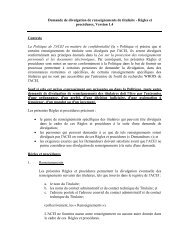
![Communiqu] - CIRA](https://img.yumpu.com/46419372/1/190x245/communiqu-cira.jpg?quality=85)
